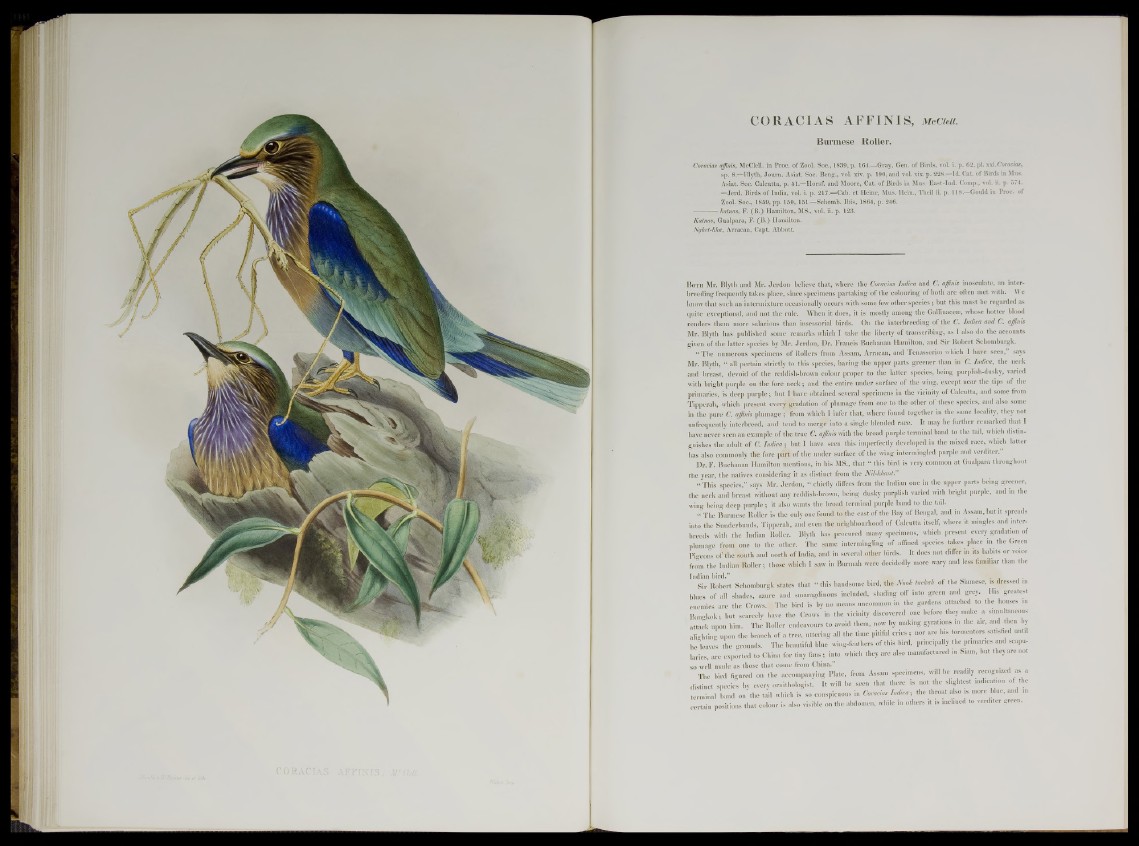
CORACIAS AFFINIS, McCieii.
Burmese Roller.
Coracias ajfmis, McClell. in Proc. of Zool. Soc., 1839, p. 164.—Gray, Gen. of Birds, vol. i. p. 62, pi. xxi.Coracias,
sp. 8.—Blyth, Journ. Asiat. Soc. Beng., vol. xiv. p. 190, and vol. xix. p. 228.—Id. Cat. of Birds in Mus.
Asiat. Soc. Calcutta, p. 51.—Horsf. and Moore, Cat. of Birds in Mus. East-Ind. Comp., vol. ii. p. 574.
—Jerd. Birds of India, vol. i. p. 217.—Cab. et Heine, Mus. Hein., Theil ii. p. 118.—Gould in Proc. of
Zool. Soc., 1859, pp. 150, 151.—Schomb. Ibis, 1864, p. 246.
------------ katnas, F. (B.) Hamilton, MS., vol. ii. p. 123.
Katnas, Gualpara, F. (B.) Hamilton.
Nghet-kha, Arracan, Capt. Abbott.
B oth Mr. Blytli and Mr. Jerdon believe that, where the Coracias Indica and C. affinis inosculate, an interbreeding
frequently takes place, since specimens partaking of the colouring of both are often met with. We
know that such an intermixture occasionally occurs with some few other species; but this must be regarded as
quite exceptional, and not the rule. When it does, it is mostly among the Gallinaceas, whose hotter blood
renders them more salacious than insessorial birds. On the interbreeding of the C. Indica and C. ajfmis
Mr. Blyth has published some remarks which I take the liberty of transcribing, as I also do the accounts
given of the latter species by Mr. Jerdon, Dr. Francis Buchanan Hamilton, and Sir Robert Schomburgk.
“ The numerous specimens of Boilers from Assam, Arracan, and renasserim which I have seen, says
Mr. Blyth, “ all pertain strictly to this species, having the upper parts greener than in C. Indica, the neck
and breast, devoid of the reddish-brown colour proper to the latter species, being purplish-dusky, varied
with bright purple on the fore neck; and the entire under surface of the wing, except near the tips of the
primaries, is deep purple; but I have obtained several specimens in the vicinity of Calcutta, and some from
Tipperah, which present every gradation of plumage, from one to the other of these species, and also some
in the pure C. affinis plumage ; from which I infer that, where found together in the same locality, they not
unfrequently interbreed, and tend to merge into a single blended race. It may be further remarked that I
have never seen an example of the true C. affinis with the broad purple terminal band to the tail, which distinguishes
the adult of C. Indica | but I have seen this imperfectly developed in the mixed race, which latter
has also commonly the fore part of the under surface of the wing intermingled purple and verditer.”
Dr. F. Buchanan Hamilton mentions, in his MS., that “ this bird is very common at Gualpara throughout
the year, the natives considering it as distinct from the Nil-khant”
“ This species,” says Mr. Jerdon, “ chiefly differs from the Indian one in the upper parts being greener,
the neck and breast without any reddish-brown, being dusky purplish varied with bright purple, and in the
wing being deep purple ; it also wants the broad terminal purple band to the tail.
“ The Burmese Roller is the only one found to the east of the Bay of Bengal, and in Assam, but it spreads
into the Sunderbunds, Tipperah, and even the neighbourhood of Calcutta itself, where it mingles and interbreeds
with the Indian Roller. Blyth has procured many specimens, which present every gradation of
plumage from one to the other. The same intermingling of affined species takes place m the Green
Pigeons of the south and north of India, and in several other birds. It does not differ in its habits or voice
from the Indian-Roller; those which I saw in Burmah were decidedly more wary and less familiar than the
Indian bird.” . . .
Sir Robert Schomburgk states that “ this handsome bird, the Nook tackah of the Siamese, is dressed in
blues of all shades, azure and smaragdinous included, shading off into green and grey. His greatest
enemies arc the Crows. The bird is by no means uncommon in the gardens attached to the houses in
Bangkok; but scarcely have the Crows in the vicinity discovered one before they make a simultaneous
attack upon him. The Roller endeavours to avoid them, now by making gyrations in the air, and then by
alighting upon the branch of a tree, uttering all the time pitiful cries ; nor are his tormentors satisfied until
he leaves the grounds. The beautiful blue wing-feathers of this bird, principally the primaries and scapu-
laries, are exported to China for tiny fans ; into which they are also manufactured in Siam, but they are not
so well made as those that come from China.” _
The bird figured on the accompanying Plate, from Assam specimens, will be readily recognized as a
distinct species by every ornithologist. It will be seen that there is not the slightest indication of the
terminal hand on the tail which is so conspicuous in Coraciat M ic a ; the throat also is more blue, and ...
certain positions that colour is also visible on the abdomen, while in others it is inclined to verditer green.